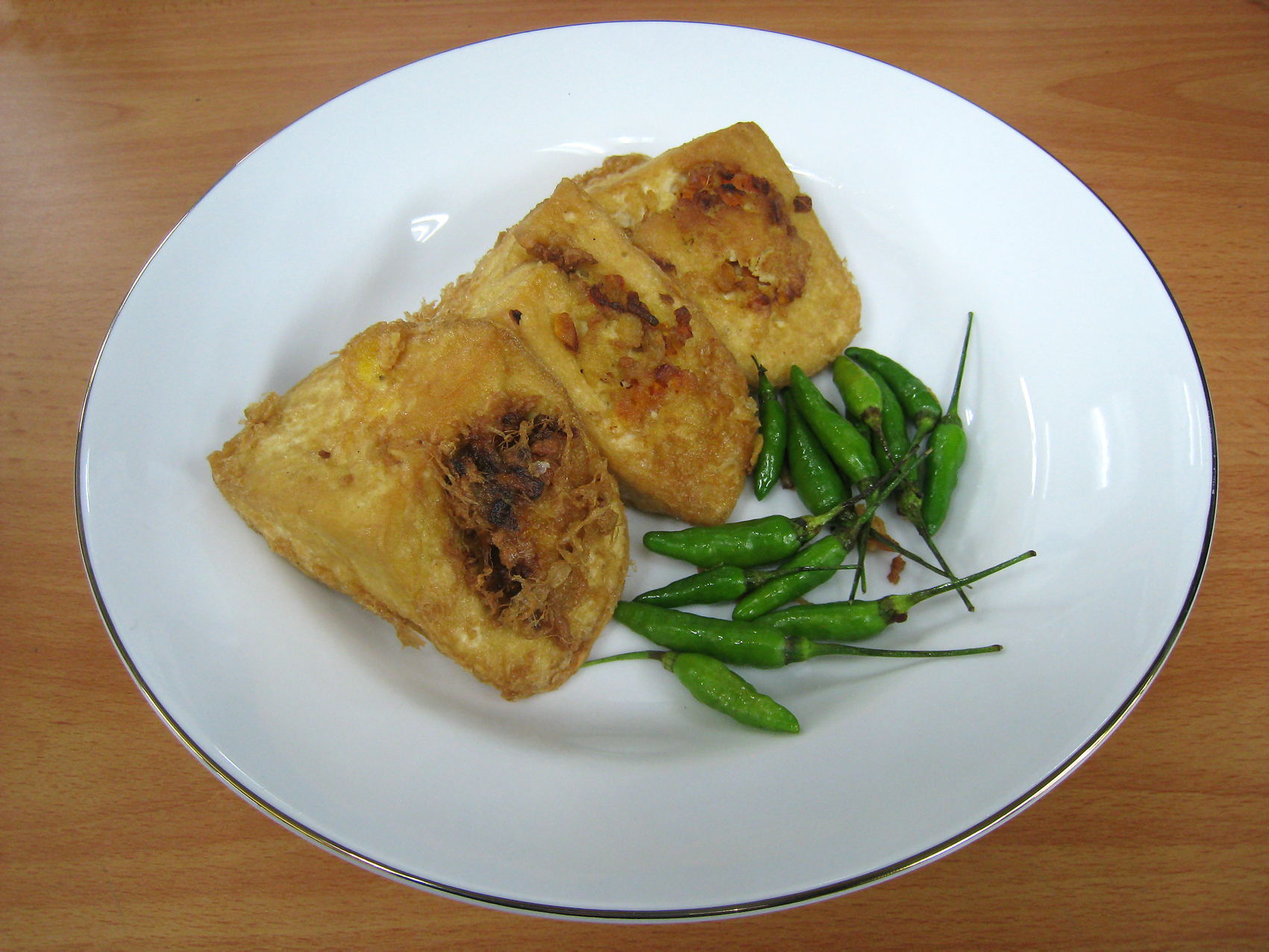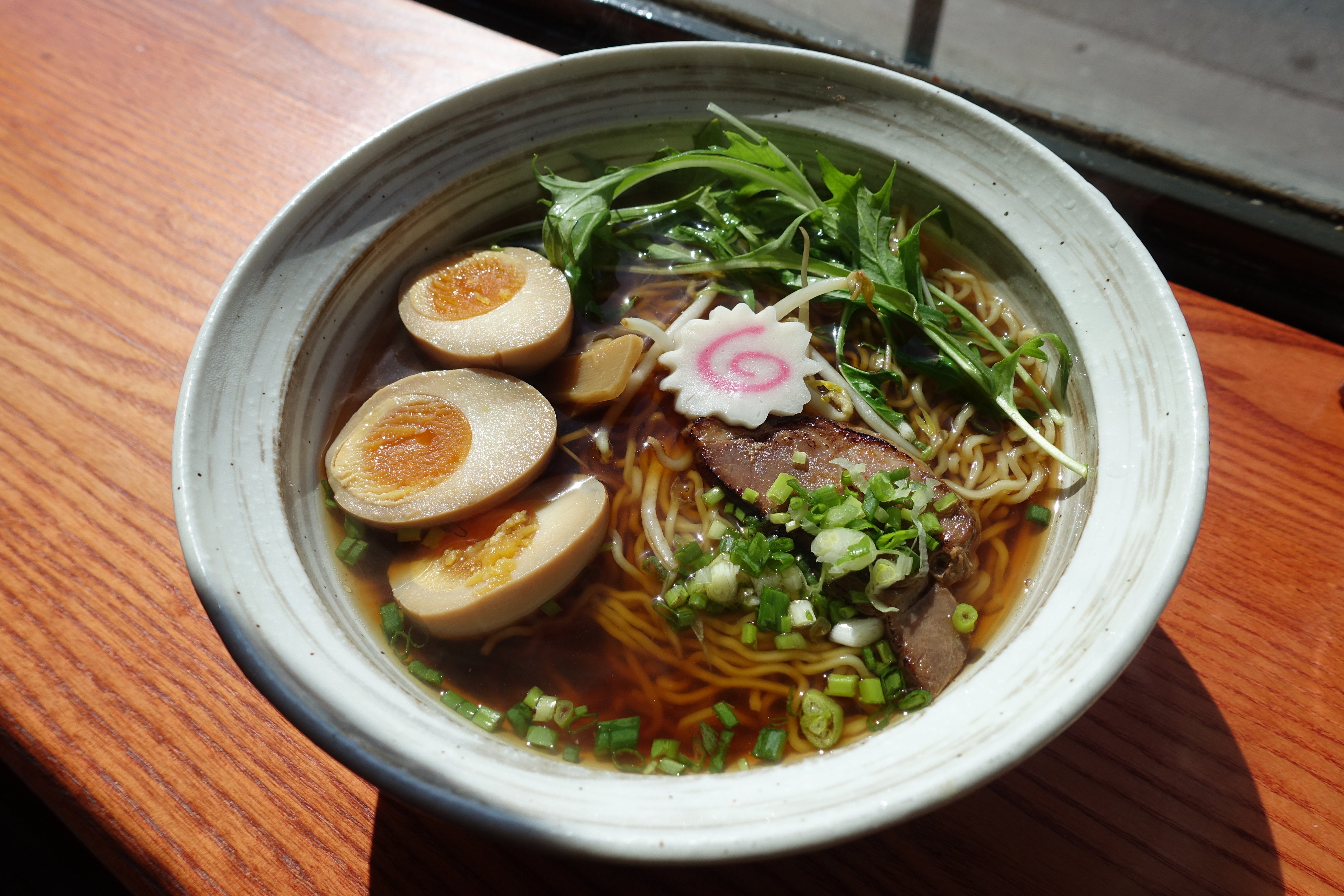|
Tahu Goreng
Tahu goreng ( Indonesian spelling) or tauhu goreng (Bruneian, Malaysian and Singaporean spelling) is a generic name for any type of fried tofu dish in the cuisines of Indonesia, Brunei, Malaysia and Singapore. Preparation When preparing the dish, cakes of hard tofu are deep-fried until golden brown. A popular way to serve fried tofu is to cut them diagonally in half and arrange on a plate garnished with bean sprouts, cucumber, and scallion. A thick sauce is prepared with shallots, garlic, chili peppers, shrimp paste, soy sauce, and tamarind juice. Cultural origins In Malay language and Indonesian, ''tauhu'' or ''tahu'' refers to 'tofu' and ''goreng'' indicates 'fried'. Tofu originated from China and was brought to Southeast Asia by Chinese immigrants to the region. Its first arrival in Indonesia is estimated through the Khubilai Khan's army in Kediri in 1292. Variations Indonesia In Indonesia, tahu goreng can be mildly fried or deep fried, plain or battered. In Indonesi ... [...More Info...] [...Related Items...] OR: [Wikipedia] [Google] [Baidu] |
Indonesia
Indonesia, officially the Republic of Indonesia, is a country in Southeast Asia and Oceania, between the Indian Ocean, Indian and Pacific Ocean, Pacific oceans. Comprising over List of islands of Indonesia, 17,000 islands, including Sumatra, Java, Sulawesi, and parts of Borneo and New Guinea, Indonesia is the world's largest archipelagic state and the List of countries and dependencies by area, 14th-largest country by area, at . With over 280 million people, Indonesia is the world's List of countries and dependencies by population, fourth-most-populous country and the most populous Islam by country, Muslim-majority country. Java, the world's List of islands by population, most populous island, is home to more than half of the country's population. Indonesia operates as a Presidential system, presidential republic with an elected People's Consultative Assembly, legislature and consists of Provinces of Indonesia, 38 provinces, nine of which have Autonomous administrative divisi ... [...More Info...] [...Related Items...] OR: [Wikipedia] [Google] [Baidu] |
Soy Sauce
Soy sauce (sometimes called soya sauce in British English) is a liquid condiment of China, Chinese origin, traditionally made from a fermentation (food), fermented paste of soybeans, roasted cereal, grain, brine, and ''Aspergillus oryzae'' or ''Aspergillus sojae'' Mold (fungus), molds. It is recognized for its saltiness and pronounced umami taste. Soy sauce was created in its current form about 2,200 years ago during the Western Han dynasty of ancient China. Since then, it has become an important ingredient in List of Asian cuisines, East and Cuisine of Southeast Asia, Southeast Asian cooking as well as a condiment worldwide. Use and storage Soy sauce can be added directly to food, and is used as a dip or Salt#Edible salt, salt flavor in cooking. It is often eaten with rice, Japanese noodles, noodles, and sushi or sashimi, or can also be mixed with ground wasabi for dipping. Bottles of soy sauce for the salty seasoning of various foods are common on restaurant tables in many co ... [...More Info...] [...Related Items...] OR: [Wikipedia] [Google] [Baidu] |
Gorengan
A fritter is a portion of meat, seafood, fruit, vegetables, or other ingredients which have been battered or breaded, or just a portion of dough without further ingredients, that is deep-fried. Fritters are prepared in both sweet and savory varieties. Definition The 1854 edition of ''An American Dictionary of the English Language'' by Noah Webster defines fritter as a transitive verb meaning "to cut meat into small pieces to be fried". Another definition from 1861 is given as "a pancake cont. chopped fruit, poultry, fish; also a small piece of meat fried". Varieties Africa West African countries have many variations similar to fritters. The most common process includes the blending of peeled black-eyed peas with peppers and spices to leave a thick texture. A Yoruba version, akara, is a popular street snack and side dish in Nigerian culture. Another popular fritter made by Nigerians is ' puff-puff'. Typically made by deep frying a dough containing flour, yeast, sugar, bu ... [...More Info...] [...Related Items...] OR: [Wikipedia] [Google] [Baidu] |
SBS Australia
The Special Broadcasting Service (SBS) is an Australian hybrid-funded public service broadcaster. About 80 percent of funding for the company is derived from tax revenue. SBS operates six TV channels ( SBS, SBS Viceland, SBS World Movies, SBS Food, NITV and SBS WorldWatch) and seven radio networks (SBS Radios 1, 2 and 3, Arabic24, SBS Chill, SBS South Asian and SBS PopAsia). SBS is also home to SBS On Demand video streaming service. The stated purpose of SBS is "to provide multilingual and multicultural radio and television services that inform, educate and entertain all Australians and, in doing so, reflect Australia's multicultural society".SBS: Frequently Asked Questions SBS Corporation, accessed 26 May 2007 SBS is one of five main |
Carrot
The carrot ('' Daucus carota'' subsp. ''sativus'') is a root vegetable, typically orange in colour, though heirloom variants including purple, black, red, white, and yellow cultivars exist, all of which are domesticated forms of the wild carrot, ''Daucus carota'', native to Europe and Southwestern Asia. The plant probably originated in Iran and was originally cultivated for its leaves and seeds. The carrot is a biennial plant in the umbellifer family, Apiaceae. World production of carrots (combined with turnips) for 2022 was 42 million tonnes, led by China producing 44% of the total. The characteristic orange colour is from beta-carotene, making carrots a rich source of vitamin A. A myth that carrots help people to see in the dark was spread as propaganda in the Second World War, to account for the ability of British pilots to fight in the dark; the real explanation was the introduction of radar. Etymology The word is first recorded in English around 1530 and w ... [...More Info...] [...Related Items...] OR: [Wikipedia] [Google] [Baidu] |
Peanut Sauce
Peanut sauce, satay sauce (saté sauce), ''bumbu kacang'', ''sambal kacang'', or ''pecel'' is an Indonesian cuisine, Indonesian sauce made from ground roasted or fried peanuts, widely used in Indonesian cuisine and many other dishes throughout the world. Peanut sauce is used with meat and vegetables, with grilled skewered meat, such as satay, poured over vegetables as salad dressing such as in ''gado-gado'', or as a dipping sauce. Ingredients Many different recipes for making peanut sauces exist, resulting in a variety of flavours, textures and consistency. The main ingredient is ground roasted peanuts, for which peanut butter can act as a substitute. Other typical ingredients include coconut milk, soy sauce, tamarind, galangal, garlic, and spices (such as coriander seed or cumin). Other possible ingredients are chili peppers, sugar, fried onion, and lemongrass. The texture and consistency of a peanut sauce mainly reflect the amount of water being mixed in it. Regional Ind ... [...More Info...] [...Related Items...] OR: [Wikipedia] [Google] [Baidu] |
Kecap Manis
Sweet soy sauce (; ) is a sweetened aromatic soy sauce, originating in Indonesia, which has a darker color, a viscous syrupy consistency, and a molasses-like flavor due to the generous addition of palm sugar or jaggery. ''Kecap manis'' is widely used with satay. It is similar to, though finer in flavor than, Chinese Tianmian sauce (''tianmianjiang''). It is by far the most popular type of soy sauce employed in Indonesian cuisine and accounts for an estimated 90 percent of the nation's total soy sauce production. Ingredients Compared to ''kecap asin'', the mildly salty regular soy sauce, the sweet soy sauce has a slightly thicker consistency and tastes much sweeter. This condiment is made from a fermented paste of boiled black soybeans, roasted grain, salt, water, and '' Aspergillus wentii'' mold, to which palm sugar is added. The strong sweet taste is contributed by a generous amount of palm sugar — the sauce may contain up to 50 percent ''gula merah'' or ''gula jawa'' (palm s ... [...More Info...] [...Related Items...] OR: [Wikipedia] [Google] [Baidu] |
Sambal
Sambal is an Indonesian chili sauce or paste, typically made from a mixture of chillis with secondary ingredients such as shrimp paste (terasi), garlic, ginger, shallot, scallion, palm sugar, and lime juice. ''Sambal'' is an Indonesian loanword of Javanese origin ( ). In addition to Indonesian cuisine, sambal is also an integral part of the cuisines of Singapore, Malaysia, Brunei, and Sri Lanka. It has also spread through overseas Indonesian populations to the Netherlands and Suriname. (Indonesian) Different sambal recipes are served as hot and spicy condiments for dishes, such as '' lalab'' (raw vegetables), '' ikan bakar'' (grilled fish), '' ikan goreng'' (fried fish), '' ayam goreng'' (fried chicken), '' ayam penyet'' (smashed chicken), '' iga penyet'' (ribs), and various '' soto'' soups. There are at least 212 variants of sambal in Indonesia, most of which originate in Java. History Sambal is often described as a hot and spicy Indonesian relish. However, its m ... [...More Info...] [...Related Items...] OR: [Wikipedia] [Google] [Baidu] |
Batter (cooking)
Batter is a flour mixture with liquid and other ingredients such as sugar, salt, egg, milk and leavening agent, leavening used for cooking. Batters are a pourable consistency that cannot be kneaded. Batter is most often used for cake, pancakes and as a coating for fried foods. It is also used for a variety of batter breads. The word ''batter'' comes from the French word ''battre'', which means ''to beat'', as many batters require vigorous beating or whisking in their preparation. Methods Many batters are made by combining dry flours, flour with liquids such as water, milk, or egg as food, eggs. Batters can also be made by soaking grains in water and grinding them wet. Often a leavening agent such as baking powder is included to aerate and fluff up the batter as it cooks, or the mixture may be naturally Fermentation (food), fermented for this purpose as well as to add flavour. Carbonated water or another carbonated liquid such as beer may instead be used to aerate the batter i ... [...More Info...] [...Related Items...] OR: [Wikipedia] [Google] [Baidu] |
TAHU GORENG
Tahu goreng ( Indonesian spelling) or tauhu goreng (Bruneian, Malaysian and Singaporean spelling) is a generic name for any type of fried tofu dish in the cuisines of Indonesia, Brunei, Malaysia and Singapore. Preparation When preparing the dish, cakes of hard tofu are deep-fried until golden brown. A popular way to serve fried tofu is to cut them diagonally in half and arrange on a plate garnished with bean sprouts, cucumber, and scallion. A thick sauce is prepared with shallots, garlic, chili peppers, shrimp paste, soy sauce, and tamarind juice. Cultural origins In Malay language and Indonesian, ''tauhu'' or ''tahu'' refers to 'tofu' and ''goreng'' indicates 'fried'. Tofu originated from China and was brought to Southeast Asia by Chinese immigrants to the region. Its first arrival in Indonesia is estimated through the Khubilai Khan's army in Kediri in 1292. Variations Indonesia In Indonesia, tahu goreng can be mildly fried or deep fried, plain or battered. In Indonesi ... [...More Info...] [...Related Items...] OR: [Wikipedia] [Google] [Baidu] |
Kublai Khan
Kublai Khan (23 September 1215 – 18 February 1294), also known by his temple name as the Emperor Shizu of Yuan and his regnal name Setsen Khan, was the founder and first emperor of the Mongol-led Yuan dynasty of China. He proclaimed the dynastic name "Great Yuan" in 1271, and ruled Yuan China until his death in 1294. Kublai was the second son of Tolui by his chief wife Sorghaghtani Beki, and a grandson of Genghis Khan. He was almost 12 when Genghis Khan died in 1227. He had succeeded his older brother Möngke as Khagan in 1260, but had to defeat his younger brother Ariq Böke in the Toluid Civil War lasting until 1264. This episode marked the beginning of the division of the Mongol Empire. Kublai's real power was limited to the Yuan Empire, even though as Khagan he still influenced the Ilkhanate and, to a significantly lesser degree, the Golden Horde. In 1271, Kublai established the Yuan dynasty and formally claimed orthodox succession from prior Chinese dynasties. ... [...More Info...] [...Related Items...] OR: [Wikipedia] [Google] [Baidu] |
Southeast Asia
Southeast Asia is the geographical United Nations geoscheme for Asia#South-eastern Asia, southeastern region of Asia, consisting of the regions that are situated south of China, east of the Indian subcontinent, and northwest of the Mainland Australia, Australian mainland, which is part of Oceania. Southeast Asia is bordered to the north by East Asia, to the west by South Asia and the Bay of Bengal, to the east by Oceania and the Pacific Ocean, and to the south by Australia (continent), Australia and the Indian Ocean. Apart from the British Indian Ocean Territory and two out of Atolls of the Maldives, 26 atolls of the Maldives in South Asia, Maritime Southeast Asia is the only other subregion of Asia that lies partly within the Southern Hemisphere. Mainland Southeast Asia is entirely in the Northern Hemisphere. Timor-Leste and the southern portion of Indonesia are the parts of Southeast Asia that lie south of the equator. The region lies near the intersection of Plate tectonics, ... [...More Info...] [...Related Items...] OR: [Wikipedia] [Google] [Baidu] |









